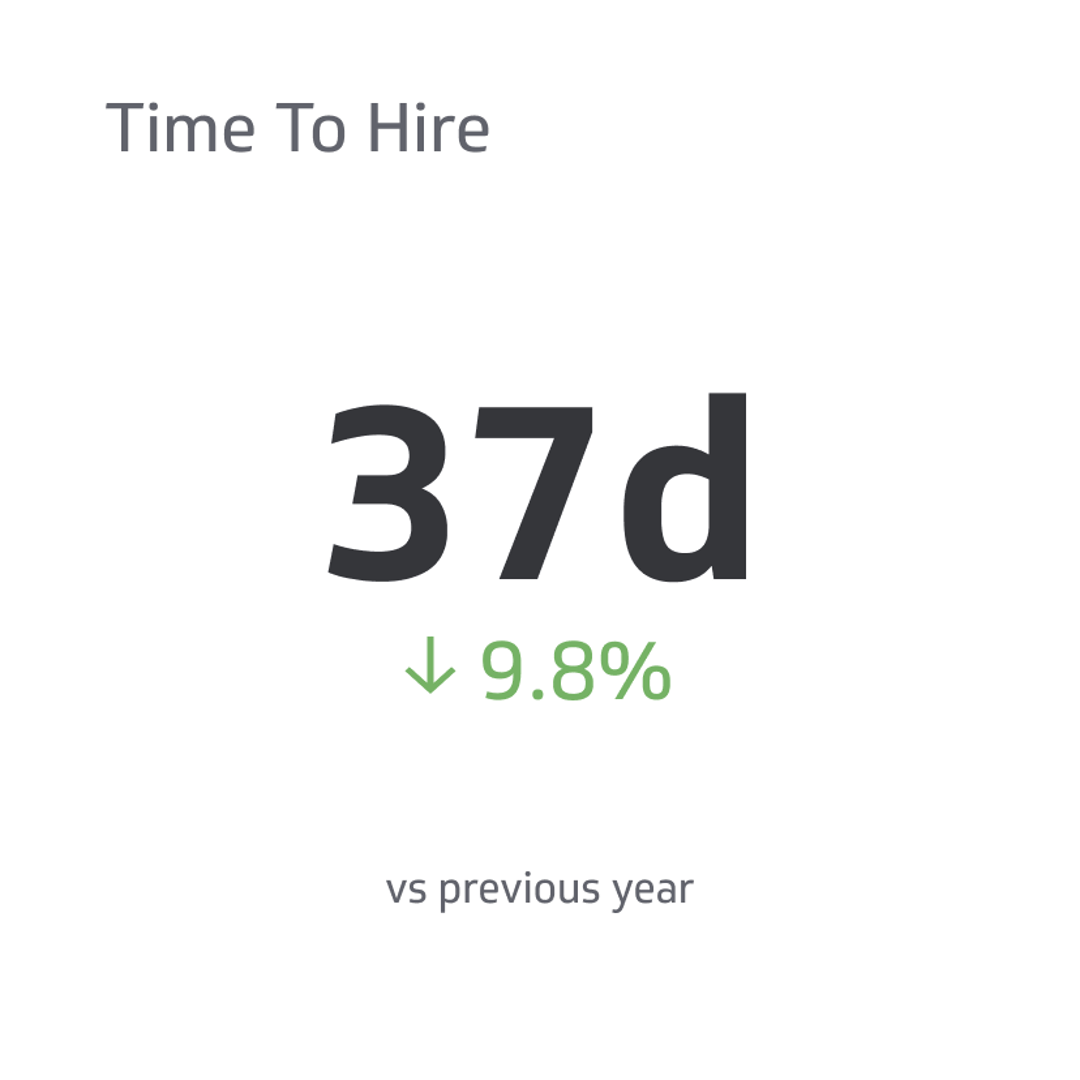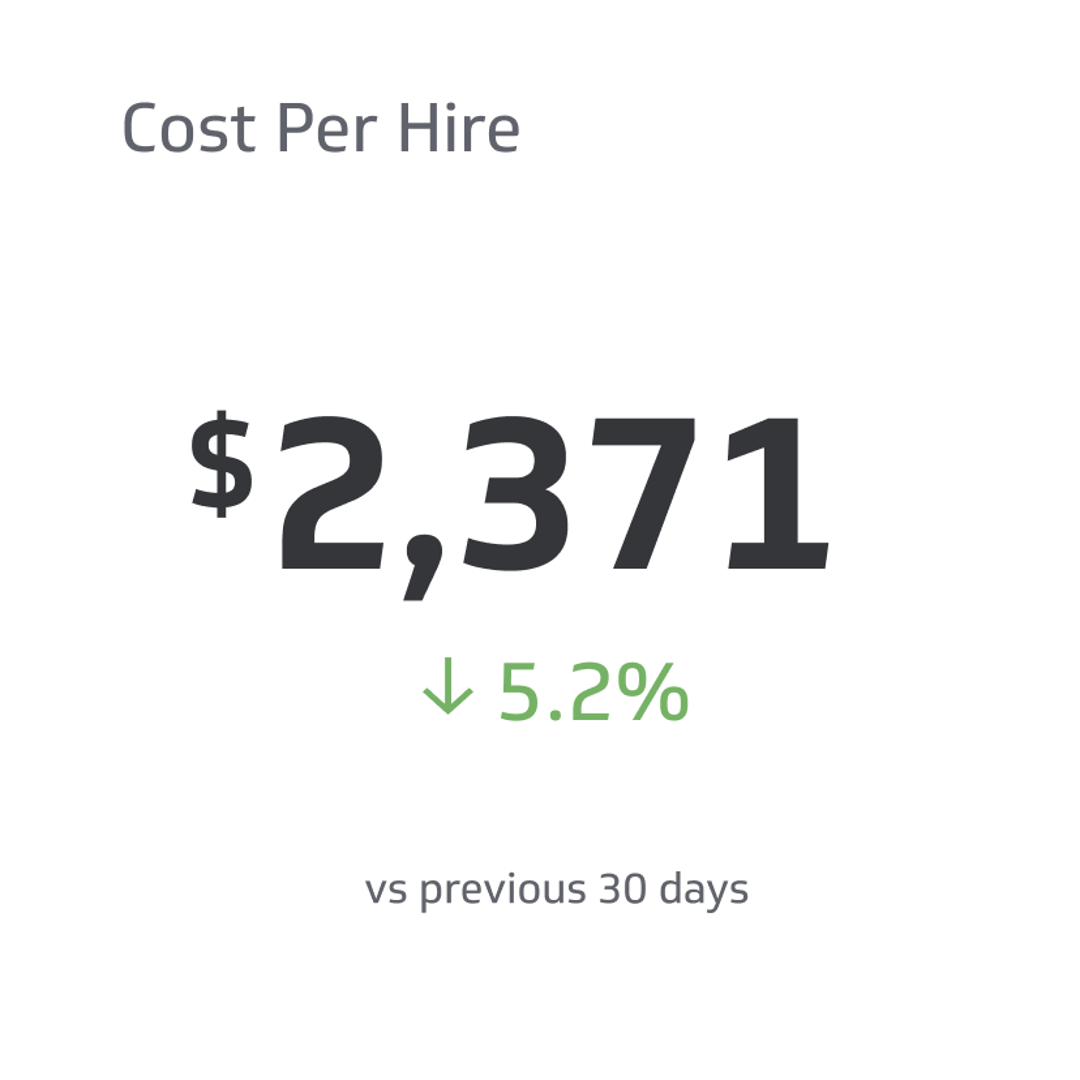Time To Hire
This metric refers to the total time between a job posting and a candidate’s acceptance of the company’s offer.
Track all your HR KPIs in one place
Sign up for free and start making decisions for your business with confidence.

Finding high-quality candidates in a time-efficient manner is a tough challenge for businesses, and slow recruitment processes may lead to lost opportunities and increased costs. This is why improving your “time to hire” is key.
Time to hire is the total duration between a company’s job posting and a candidate’s acceptance of the role, and it’s a pertinent recruitment metric that every business must consider to improve recruitment efficiencyThis article will explore the significance of time to hire and explain how to improve it. We’ll look at common barriers and best practices for optimizing recruitment practices and achieving a shorter hiring time.
What Is Time To Hire?
Time to hire is a recruitment metric, which refers to the total time between a job posting and a candidate’s acceptance of the company’s offer.
It’s a critical indicator of how efficiently a company's recruitment process attracts, scans, evaluates, and selects suitable candidates for a role.
A shorter time to hire means that the company can fill positions quickly, reducing the cost of vacancies and ensuring that essential roles are not left unfilled for too long.
On the other hand, a longer time to hire can result in losing top candidates to competitors or lead to higher recruitment costs due to prolonged advertising, screening, and interviewing processes.
Therefore, businesses must monitor and improve their hiring time to stay competitive in the job market.
Why Should You Measure Time To Hire?
Measuring the time to hire is crucial for businesses as it provides valuable insights into the effectiveness and efficiency of their recruitment process. By tracking this HR metric, companies can identify bottlenecks and areas for improvement in their hiring process, such as lengthy job postings, slow candidate screening, or delayed feedback to applicants.
Moreover, time to hire can help companies set realistic hiring goals, allocate resources more effectively, and adjust their recruitment strategy to meet market demands. For instance, if a company's time to hire is longer than the industry average, it may indicate the need to improve the candidate experience, provide more attractive job offers, or use more effective sourcing methods.
In contrast, a shorter hiring time can signal successful recruitment efforts and an effective talent acquisition strategy. Ultimately, measuring time to hire can help businesses optimize recruitment processes, reduce recruitment costs, and attract top talent faster.
Factors That Affect Time To Hire
Several factors may affect a company's hiring time, e.g., candidate availability, candidate overall experience, recruitment process efficiency, job market conditions, brand image, company reputation, and a hiring manager's decision-making process.
Job market conditions, such as high demand for specific skills or low unemployment rates, can increase talent competition, making it harder for companies to find and attract suitable candidates. Recruitment process efficiency is also critical, as delays in scheduling interviews, obtaining feedback, or conducting background checks can prolong hiring time.
Candidate availability can affect the hiring time, as in-demand candidates may receive multiple offers, causing delays in the decision-making process. A company's reputation and brand image can also have a significant impact, as candidates may be more willing to apply to companies with positive reviews or a strong employer brand.
Finally, different aspects of human resources can have an impact. Hiring managers' decision-making processes can significantly extend hiring time, as indecisiveness or unclear expectations can lead to candidate drop-offs or prolonged hiring cycles.
Best Practices for Time To Hire
Businesses should follow several best practices that can improve the efficiency and effectiveness of their recruitment process.
Setting clear, realistic expectations for the hiring process - such as the timeline, required qualifications, and expected outcomes - can ultimately help both candidates and hiring managers avoid misunderstandings and reduce the time needed for decision-making.
Job Requirements and Essential Skills
Prioritizing job requirements and identifying essential skills and experience can help recruiters focus their search efforts on the most critical aspects of the role. Thirdly, creating a diverse candidate pool can help companies tap into a broader talent pool and increase the likelihood of finding suitable candidates quickly.
Communication and Tracking Metrics
Communicating with candidates effectively and providing timely feedback can help build a positive candidate experience, reduce drop-off rates, and maintain candidate engagement throughout the hiring process.
Tracking and analyzing recruitment metrics, including time to hire, can help companies identify areas for improvement and measure the success of their recruitment efforts over time. Implementing these best practices can help businesses optimize their recruitment process, reduce hiring time, and attract top talent more efficiently.
Common Challenges and Solutions With Time To Hire
Several common challenges can affect a company's hiring time, such as skill shortages in the job market, high candidate drop-off rates, inefficient recruitment processes, hiring manager indecisiveness, and budget constraints.
Addressing Skill Shortages
When there’s limited talent available in the area with the required skills and experience, businesses call this a skill shortage.
Skill shortages occur when the demand for specific skills exceeds the available supply of qualified candidates in the job market, making it challenging to find suitable candidates.
Companies may take longer to fill open positions as a result, which can lead to delays in completing critical projects and achieving business objectives.
To overcome skill shortages, companies can adopt strategies such as:
- offering competitive compensation packages
- investing in employee training and development programs, and
- expanding their recruitment efforts to target a broader pool of candidates.
Furthermore, companies can partner with educational institutions and industry associations to promote and develop the required skills and encourage more individuals to pursue careers in the field.
Overcoming Indecision
Indecision by human resources can significantly impact the time to hire. The hiring process typically involves multiple stakeholders, and when one stakeholder, such as human resources, is indecisive, it can cause delays and affect the overall recruitment process's efficiency.
HR professionals may be indecisive when they have conflicting priorities or lack a clear understanding of the job requirements and the candidate's qualifications. Indecisiveness can lead to multiple rounds of interviews and delays in providing feedback, which can cause candidates to lose interest in the position or accept offers from other companies.
How To Measure Time To Hire?
To measure the time to hire, businesses should determine the starting point of the recruitment process, such as when the job opening is posted or when the recruitment process officially begins.
Then, they should measure the time it takes to fill the position from the job posting date to the candidate's acceptance date.
To get accurate time-to-hire measurements, companies can track recruitment process data like the number of applicants, the interview process duration, and the candidate's acceptance period.
Can a Company Layoff and Hire at the Same Time?
Yes. It’s not unusual for companies to lay off employees while simultaneously hiring for other roles.
Though, doing this simultaneously can affect a company's time to hire, as the recruitment process may take longer than expected with more roles to fill, and the layoffs may cause negative impacts on the company's reputation and employer brand.
Layoffs can also cause potential candidates to question the stability and viability of the company, leading to a smaller pool of candidates and a longer time to hire.
However, there are steps that companies can take to minimize the adverse effects of layoffs on their recruitment efforts. These steps include:
- Establishing transparency with candidates throughout the hiring process
- Investing in the company’s overall brand and public messaging
- Maintaining a positive relationship with former employees
- Prioritizing critical roles during the hiring process
Time To Hire vs. Time To Fill
Time to hire and time to fill are two metrics businesses use to measure the recruitment process's efficiency. Time to Hire measures the time it takes from posting a job opening to the candidate accepting the offer.
Meanwhile, time to fill measures the time it takes to fill a position, from posting a job opening to the candidate starting the job.
While both metrics are essential, they have different implications for businesses. Time to hire is a more critical metric as it measures the time it takes to attract and hire top talent, ensuring that companies remain competitive.
In contrast, time to fill can be affected by external factors such as the candidate's notice period, which may not be in the company's control.
Methods To Improve Time To Hire
Reducing hiring time is crucial for companies to attract and hire top talent quickly and efficiently. There are several methods that companies can implement to improve their time to hire.
- Leveraging technology for a “candidate-friendly” experience
- Streamlining the recruitment process
- Reducing the time between interviews or rounds
- Developing a strong brand
- Setting realistic expectations for their hiring managers
First off, utilizing new technology is one of the most cost-efficient and effective ways of hiring faster.
Leveraging modern technology for recruitment, such as applicant tracking systems, can automate and streamline the recruitment process, reducing manual errors and speeding up the hiring process.
Additionally, developing a strong employer brand by promoting a positive image of the company and investing in employee development can attract more qualified candidates, reducing the time to hire.
Further, improving the candidate experience can also be an effective way of reducing hiring time. You can take positive steps to improve communication and keep candidates engaged and motivated throughout the recruitment process.
Finally, providing timely feedback to candidates, such as after interviews, can reduce candidate drop-off rates and maintain engagement, ultimately reducing hiring time.
Wrap-up
Companies can integrate various best practices like setting realistic expectations, prioritizing job requirements, streamlining the recruitment process, communicating with candidates, and tracking and analyzing recruitment metrics to improve the hiring time.
Despite common challenges such as skill shortages, high candidate drop-off rates, inefficient recruitment processes, hiring manager indecisiveness, and budget constraints, companies can overcome these challenges. In summary, by prioritizing time to hire and implementing best practices, companies can attract and hire top talent more efficiently and remain competitive.
Related Metrics & KPIs



